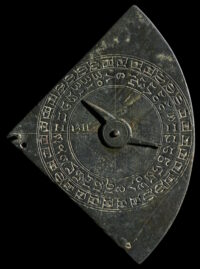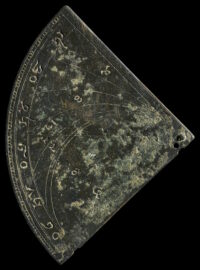 A copper horary quadrant, a timepiece, calendar and altitude calculator, inscribed with the year 1311 on the reverse side, making it the oldest dated English scientific instrument, will be going under the hammer at Christie’s on December 13th.
A copper horary quadrant, a timepiece, calendar and altitude calculator, inscribed with the year 1311 on the reverse side, making it the oldest dated English scientific instrument, will be going under the hammer at Christie’s on December 13th.
Engraved on the obverse curved, unequal hour lines and a quadrant arc with numbered scales, the dated reverse of the thin copper plate had a spinning index pointer that could be used to calculate the height of an object, the altitude of the sun and the date of Easter Sunday.
It also contains a sundial that tells the time, which in medieval England was commonly divided into 12 hour-long segments between sunrise and sunset. This meant that each hour was longer in summer than in winter — which was useful when daylight was crucial to working the land.
The ingenious science behind this device, which remained in use in one form or another for nearly a millennium, can be traced back to a manuscript produced in Baghdad in the 9th or 10th century. The city was a cosmopolitan centre of learning, which fed into Europe through Al-Andalus, the area of the Iberian peninsula that was under Muslim rule between the 8th and 15th centuries. […]
These quadrants were probably the tools of merchants, senior churchmen and scholars,’ explains Hyslop. ‘The knowledge they provided would have revolutionised the way people in the Middle Ages lived.’
 Very few early examples of horary quadrants have survived. One discovered in 2015 by metal detectorist Simon Neal near what had once been an Augustinian priory at Chetwode in Buckinghamshire, has notable similarities to the 1311 example. The metal composition, dimensions and engraving style are so similar that the two pieces were not only manufactured in the same workshop, but likely by the hand of the same unknown horologer now dubbed the master of the Chetwode Quadrant.
Very few early examples of horary quadrants have survived. One discovered in 2015 by metal detectorist Simon Neal near what had once been an Augustinian priory at Chetwode in Buckinghamshire, has notable similarities to the 1311 example. The metal composition, dimensions and engraving style are so similar that the two pieces were not only manufactured in the same workshop, but likely by the hand of the same unknown horologer now dubbed the master of the Chetwode Quadrant.
The pre-sale estimate is £100,000–£150,000 ($125,000–$188,000). Even the high estimate is modest. A medieval quadrant dating to 1388 that was discovered in Canterbury in 2005 sold for £138,000. The buyer applied for an export license and the Culture Minister placed a temporary ban on export as an object of exceptional cultural interest. The British Museum was able to raise the matching funds in time and it is now on display.
That’s definitely a lot of money! Has the machine been TESTED? …What is the Last Price?
In the West, Easter Sunday is the first Sunday in Spring after the first Full Moon (Spring and in theory 1st Full Moon on 21st of March). Hence, the first possible Easter Sunday would be March 22nd, the latest the 25th of April:
X:=2024;
K:= X div 100;
M:= 15 + ((3*K + 3) div 4) – ((8*K + 13) div 25);
S:= 2 – ((3*K + 3) div 4);
A:= X mod 19;
F:= (19*A + M) mod 30;
R:= (F + A div 11) div 29;
OG:= 21 + F – R;
SZ:= 7 – (X + (X div 4) + S) mod 7;
OE:= 7 – (OG – SZ) mod 7;
OSM:= OG + OE;
OSA:= OSM-31;
[OSM,OSA]
Result: [31, 0] Thus, for 2024 in the West, Easter Sunday is the 31st of March, and 0th of April. 🌿️ 🐈️